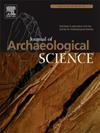航海巨石:西班牙瓦伦西纳Matarrubilla巨石盆地的地质考古研究
IF 2.5
1区 地球科学
Q1 ANTHROPOLOGY
引用次数: 0
摘要
采用广泛的多学科方法来研究一个特殊的巨石特征:马塔鲁比拉·索洛斯(Matarrubilla tholos)墓室的石盆,这是瓦伦锡纳铜器时代大型遗址(西班牙塞维利亚)的一部分。这项研究,包括地质考古特征和石头的来源,基于摄影测量学和形态测量学对其表面进行的痕迹学分析,数字图像分析以及OSL年代测定,导致了许多实质性的发现,这些发现对理解这个石头盆地的意义具有重要意义,这是伊比利亚半岛唯一记录到这一日期的石头盆地,只有在爱尔兰和马耳他。在最相关的结论中,值得注意的是,形成盆地的石膏质碎裂岩块是5000年前从海洋海湾的另一边带到瓦伦西纳东南部的,这是伊比利亚半岛巨石水上运输的第一个证据。此外,该盆地似乎是在公元前4千年上半叶的某个时候被放置在今天的位置上的,远远早于在瓦伦西纳建造任何托洛伊,这表明这个巨型遗址之前的历史仍然缺乏文献记载。本文章由计算机程序翻译,如有差异,请以英文原文为准。
Seafaring megaliths: A geoarchaeological approach to the Matarrubilla giant stone basin at Valencina (Spain)
A broad multidisciplinary approach is deployed to study an exceptional megalithic feature: the stone basin that presides over the chamber of the Matarrubilla tholos, part of the Valencina Copper Age mega-site (Sevilla, Spain). The study, including geoarchaeological characterisation and sourcing of the stone, traceological analysis of its surfaces based on photogrammetry and morphometrics, digital image analysis as well as OSL dating, leads to a number of substantial findings of great relevance to understand the significance of this stone basin, the only of its kind documented to this date in the Iberian Peninsula, with parallels only in Ireland and Malta. Among the most relevant conclusions, it is worth noting the fact that the gypsiferous cataclasite block the basin was made of was brought from the other side of the marine bay that five thousand years ago extended across the south-east of Valencina, this is the first evidence of waterborne transport of a megalithic stone in the Iberian Peninsula. In addition, the basin appears to have been put where it stands today sometime in the first half of the 4th millennium BC, long before any tholoi were built at Valencina, which suggest a prior history of still poorly documented monumentality at this mega-site.
求助全文
通过发布文献求助,成功后即可免费获取论文全文。
去求助
来源期刊

Journal of Archaeological Science
地学-地球科学综合
CiteScore
6.10
自引率
7.10%
发文量
112
审稿时长
49 days
期刊介绍:
The Journal of Archaeological Science is aimed at archaeologists and scientists with particular interests in advancing the development and application of scientific techniques and methodologies to all areas of archaeology. This established monthly journal publishes focus articles, original research papers and major review articles, of wide archaeological significance. The journal provides an international forum for archaeologists and scientists from widely different scientific backgrounds who share a common interest in developing and applying scientific methods to inform major debates through improving the quality and reliability of scientific information derived from archaeological research.
 求助内容:
求助内容: 应助结果提醒方式:
应助结果提醒方式:


